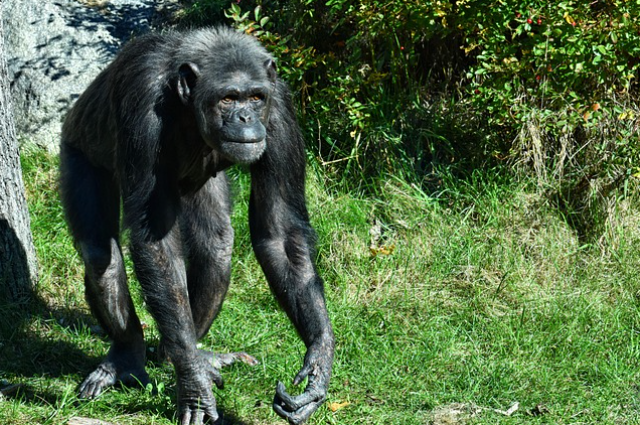
In a discovery that is changing how we view our closest animal relatives, scientists have documented a truly remarkable behavior: chimpanzees treating each other’s wounds using medicinal plants. For the first time ever, wild chimps have been seen not only self-medicating but also administering first aid to other injured members of their group.
The study, published in Nature Communications, offers compelling video evidence from the Loango National Park in Gabon, Central Africa, where researchers observed chimpanzees catching insects or using specific plant-based materials and applying them to open wounds—not just their own, but those of their companions. This behavior opens a window into the complex social lives, empathy, and healing instincts of non-human primates.
Let’s explore what this means for science, medicine, and our understanding of the evolution of care.
A New Chapter in Animal Medicine
It all began when a group of researchers from the Ozouga Chimpanzee Project, led by Dr. Tobias Deschner and Dr. Simone Pika, captured an astonishing moment on video: an adult female chimp named Suzee applying a crushed insect directly to a wound on her adolescent son’s leg. The scene was something few could imagine—a wild animal, clearly tending to another’s injury with care and precision.
Throughout the study, the team observed over 76 instances of similar behavior among 22 different chimps. These included:
- Chimps catching unknown insects or plants
- Crushing them between their lips or fingers
- Gently dabbing the mixture onto open cuts or wounds
- Sometimes blowing on the wound afterward
The most surprising part? In many cases, the chimpanzees were treating others—not just themselves. This goes beyond self-medication; it strongly suggests prosocial behavior and even a form of primitive healthcare.
The Science Behind the Behavior
While it’s well-known that many animals, especially primates, eat certain plants to treat internal parasites or stomach upsets (a phenomenon known as zoo pharmacognosy), the idea of topical treatment—and especially applying it to others—has never been recorded until now.
According to Dr. Pika, a cognitive biologist from the University of Osnabrück in Germany:
“We were completely shocked. This is the first time we’ve seen animals treating others with a substance. It may imply a degree of empathy or understanding of another’s pain.”
The actual substance being applied is still under investigation. Early analysis suggests it could be specific types of insects or chewed leaves with antimicrobial or anti-inflammatory properties, but confirming their medicinal value will take further chemical study.
A Window into Primate Empathy and Cooperation
What makes this discovery even more groundbreaking is that it points to emotional intelligence among chimpanzees. While humans are known for their ability to empathize and care for others, this footage shows that chimps may share that trait on a much deeper level than previously thought.
Chimpanzees are already known for complex behaviors:
- Tool use (like using sticks to fish for termites)
- Hunting strategies in groups
- Mourning their dead
- Forming lifelong friendships and alliances
But administering medical treatment to others suggests a deeper understanding of cause and effect, pain, and compassion.
One documented incident shows an adult male chimp carefully tending to a gash on a juvenile’s foot, applying the plant-based substance with precision, and then staying close afterward. Such nurturing behavior is not only rare but challenges what we thought we knew about animal cognition.
What This Means for Human Evolution
This discovery sheds light on the evolution of caregiving and medicine in humans. If our primate cousins are capable of such complex behavior, it may mean that the roots of our medical systems go back millions of years—long before hospitals, doctors, or even language.
Anthropologist Dr. Frans de Waal, not involved in the study, commented:
“This behavior shows that empathy, helping, and even healing may be part of our shared ancestry. It’s not something that emerged suddenly with Homo sapiens.”
Some scientists are now calling for a reevaluation of how we define medicine, intelligence, and even morality in the animal kingdom.
Cultural Knowledge Among Chimps?
One intriguing aspect of the study is the possible transmission of knowledge within the chimpanzee group. Younger chimps appeared to learn by watching older members treat wounds. In some cases, chimps returned to the same plants or spots to retrieve their healing materials.
This points to culture—the passing down of knowledge and behavior from one generation to the next—something previously only associated with humans and a handful of species.
Dr. Deschner noted:
“This isn’t random. These chimps know what they’re doing. They may not understand biology as we do, but they’re aware of which plants or insects have beneficial effects.”
What's Next for the Research?
The Ozouga Chimpanzee Project team is now working with chemists and botanists to identify the substances used in these first-aid treatments. They hope to discover whether they contain antibiotic, antifungal, or pain-relieving properties—which could not only confirm their medical value but even inspire new drug research.
Moreover, researchers are planning to expand their observation efforts to other chimpanzee groups across Africa. If similar behavior is found elsewhere, it would indicate that this is not an isolated case but a widespread phenomenon among chimp populations.
Final Thoughts: Rethinking the Line Between Humans and Animals
This groundbreaking observation of chimpanzees tending to each other’s wounds with plant-based remedies forces us to reflect on how much more we share with animals than we think.
While science has long emphasized what makes humans unique—language, tools, complex thought—discoveries like this continue to blur the lines. Chimps, it seems, are not just like us in appearance or DNA (they share about 98.8% of ours), but in heart and instinct too.
Perhaps the next time we think about compassion or caregiving as uniquely human traits, we’ll remember that somewhere in the forests of Gabon, a chimp carefully presses a healing leaf onto a friend’s wound—just as a human doctor might apply a bandage.
